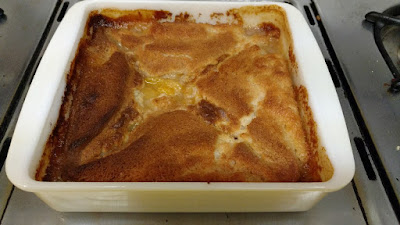
Recipe: Summer peaches, nectarines featured in this version of Blue Ribbon Cobbler

(Photos: Debbie Arrington) |
One of the great pleasures of midsummer is a rich and satisfying fruit dessert that makes the most of a sweet-tart bounty.
My favorite is this cobbler: easier than pie and flexible to what’s ripe.
I discovered this recipe 35 years ago when I first started writing about food. “Blue Ribbon Peach Cobbler,” which according to accompanying recipe notes won top prize at an unnamed state fair, was part of Ronald Johnson’s wonderful “The American Table: A Festive Sampler of Regional Cooking at its Savory Best.” Johnson encouraged readers to substitute other fruit or combinations for the peaches, which I have done often.
In honor of closing day of our State Fair, this Blue Ribbon Cobbler will win smiles at summer gatherings. (Just use the correct size pan.)
The example here uses yellow peaches and nectarines, peeled and sliced. Strawberry-rhubarb, peach-blueberry, apple-rhubarb, mixed berries; all these combos work well, as do straight peaches or other fruit.
The recipe itself looks out of whack with way more sugar than flour, plus lots of butter. That’s what makes it delicious. The batter bubbles when it’s spooned over the melted butter, and the fruit is dropped on top, not layered underneath. As the cobbler cooks, the fruit sinks down into the batter. The top and sides develop a rich, brown crunchy crust, wrapped around sweet-tart syrupy filling.
All that sinking and rising needs some room. Use a DEEP baking dish (3 inches preferred), not a shallow pie pan. Place a cookie sheet under the baking dish to catch overflow, just in case.
Blue Ribbon Cobbler
Adapted from “The American Table,” by Ronald Johnson (Pocket Cookbook, 1984)

|
Comments
0 comments have been posted.Sacramento Digs Gardening to your inbox.
Sites We Like
Garden Checklist for week of May 5
Survey your garden after the May 4 rainstorm. Heavy rain and gusty winds can break the neck of large flowers such as roses. Also:
* Keep an eye on new transplants or seedlings; they could take a pounding from the rain.
* Watch out for powdery mildew. Warmth following moist conditions can cause this fungal disease to “bloom,” too. If you see a leaf that looks like it’s dusted with powdered sugar, snip it off.
* After the storm, start setting out tomato transplants, but wait on the peppers and eggplants (they want warmer nights). Pinch off any flowers on new transplants to make them concentrate on establishing roots instead of setting premature fruit.
* Trim dead flowers but not leaves from spring-flowering bulbs such as daffodils and tulips. Those leaves gather energy to create next year's flowers. Also, give the bulbs a fertilizer boost after bloom.
* Pinch chrysanthemums back to 12 inches for fall flowers. Cut old stems to the ground.
* Mulch around plants to conserve moisture and control weeds.
* From seed, plant beans, beets, cantaloupes, carrots, corn, cucumbers, melons, pumpkins, radishes and squash.
* Plant onion sets.
* In the flower garden, plant seeds for asters, cosmos, celosia, marigolds, salvia, sunflowers and zinnias. Transplant petunias, zinnias, geraniums and other summer bloomers.
* Plant perennials and dahlia tubers for summer bloom.
* Don’t wait; plant summer bulbs, such as gladiolus and tuberous begonias.
* Harvest cabbage, lettuce, peas and green onions.